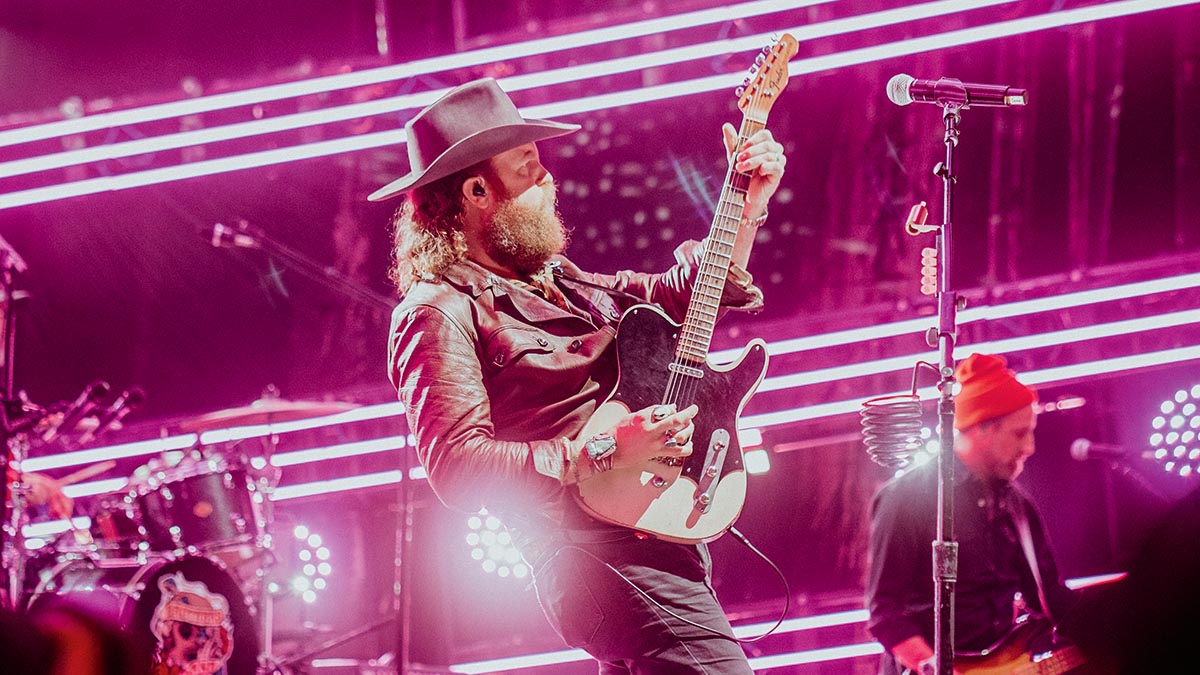John Osborne: “The Telecaster is the most versatile guitar out there… Its simplicity allows you to find your voice. It’s a desert island guitar”
The Brothers Osborne guitarist on how he discovered the Tele, trading up and why bad B-Bender technique is like too much cologne…

John Osborne knows a thing or two about the Fender Telecaster. His life, you could say, depends on it. As guitarist in the country duo the Brothers Osbourne, that slab of wood, this archetypical workhorse electric guitar, is his bread and butter.
So here, to give a little something back to Leo Fender’s revolutionary design, Osborne tells us what makes the Tele so special, and how it fits in with his sound, and why it simply goes with everything.
What does the Telecaster mean to you?
“As simple of a design as the Telecaster is, it’s the most versatile guitar out there. It just works with any style, any amp, any pedal you put in front of it. The Telecaster works so well because it’s just a guitar.
“When you add switches and knobs that do crazy things, you start getting away from the actual point of an electric guitar, which was to be loud enough to be heard over drums. Some guitars push you in a direction, and when you fight against it, it doesn’t work as well. But the simplicity of the Telecaster allows you to find your voice. It’s a desert island guitar.”
Who were the first artists to make you aware of the Telecaster?
“I’m from Maryland and grew up right outside of Washington DC. That’s where Danny Gatton was from and he was the first person I’d ever seen play a Telecaster. He had a Hot Licks video, just him with a Blackguard Tele.
All the latest guitar news, interviews, lessons, reviews, deals and more, direct to your inbox!
“For a young guitar player who had seen the Jacksons, Flying Vs and all these flashy guitars, and was quite impressed with the spectacle, to hear this guy get so many sounds and styles out of such a simple guitar – I was dumbfounded.”
What was your first Tele?
“When I was 21 I traded two guitars, a Silverface ’70s Twin and $700 to buy a ’68 Telecaster. It was the first vintage guitar I’d ever owned, my first real Telecaster, and I still play it to this day. Later, I took that neck and put it on another Tele body and had the back routed out for a Gene Parsons-style B-Bender.
“I’ve got semi-hotter pickups – and a very hot neck pickup – but those are the only modifications. The neck has been refretted a couple of times, but it’s still the same, and the tuners are original. In my opinion, the neck is 75 per cent of the guitar. That’s where you’re feeling it the most.”
Can you really get a big, punchy rock sound out of the Tele neck pickup? Not really. But Teles weren’t really made for that anyway
Some people think the stock Tele neck pickup lacks meat…
“Well, I disagree with that – without the filter, by the way. The filter is a cool sound, but it does paint you into a very specific corner and you’re stuck there. But I love the way the front pickup sounds on a Tele, specifically in the middle position, because it gives you a brighter sound than you’d get with a fatter and louder pickup in the neck.
“Can you really get a big, punchy rock sound out of the Tele neck pickup? Not really. But Teles weren’t really made for that anyway.”
How do you use the B-Bender in your playing?
“When you first have a B-Bender, it’s like the first time you bought cologne – it’s very easy to overdo. You gotta find the sweet spot. The B-Bender I have, you can get it up to two full steps – which is something I wouldn’t do at a gig because you’re gonna pop a string very quickly. I typically do the whole-step bends or bend within a held chord. And then, with practice, you can do half-step bends, which is very tricky because it’s easy to do it out of pitch.”
When you first have a B-Bender, it’s like the first time you bought cologne – it’s very easy to overdo. You gotta find the sweet spot
How does the Tele complement the rest of your rig?
“On the road currently, I use the Two-Rock brand. For that style of amplifier, Eli Lester at Two-Rock has not only perfected it but taken it to a level I never knew it could go. It gives you all the punchiness and compression you want, with added everything.
“I have the Greer Lightspeed, which is a very transparent overdrive, and an Xotic AC Booster, which is so harmonically rich. Right now, I’m using [an Ibanez] Mostortion on one ’board and the JHS Bonsai on another because that gives a ton of different green box sounds. But honestly, a Telecaster going into an amp, with a booster to give you some fatness – that’s as good as it gets.”
- Skeletons is out now via EMI Nashville.
Jamie Dickson is Editor-in-Chief of Guitarist magazine, Britain's best-selling and longest-running monthly for guitar players. He started his career at the Daily Telegraph in London, where his first assignment was interviewing blue-eyed soul legend Robert Palmer, going on to become a full-time author on music, writing for benchmark references such as 1001 Albums You Must Hear Before You Die and Dorling Kindersley's How To Play Guitar Step By Step. He joined Guitarist in 2011 and since then it has been his privilege to interview everyone from B.B. King to St. Vincent for Guitarist's readers, while sharing insights into scores of historic guitars, from Rory Gallagher's '61 Strat to the first Martin D-28 ever made.




